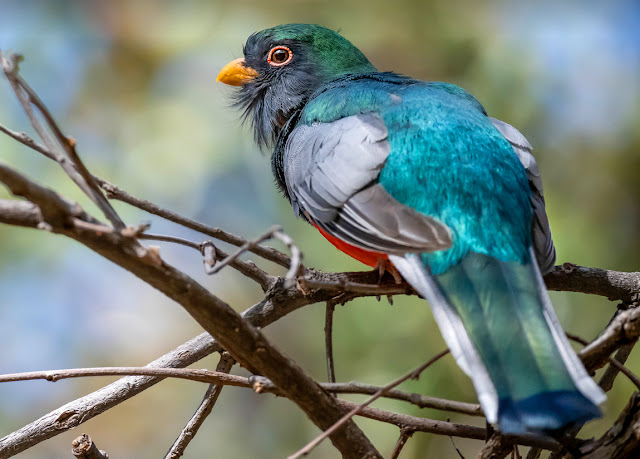Tracking Trogons: Spring in the Sky Islands
By Jennie MacFarland
 |
| Male trogon by Francis Morgan |
As temperatures climb in Southeast Arizona during the spring and summer, many of us retreat to the cooler environment that the mountains provide. Lush and scenic canyons such as Madera Canyon in the Santa Rita mountains are particularly inviting, with a flowing creek lined with large, shady sycamore trees. While visiting such a tranquil location you may hear a strange noise echoing from the trees: a repeated “kwok kwok kwok” call that sounds a bit like a frog, or the bark of a small dog (hear it at tucsonaudubon.org/trogon-call). This sound is actually the territorial call of an Elegant Trogon, a stunningly beautiful bird that is particularly special in this region. Elegant Trogons look more like a bird of the tropics, with the males having an iridescent green back, bright red belly, and long tail with black and white barring. The females are more subdued in their coloration with brown and beige tones and a pink lower belly. There are dozens of species of trogons in the tropics, but the Elegant Trogon has the distinction of being the only species that has a nesting population in the United States, and they are all within Southeast Arizona.
The mountains of Southeast Arizona add to the rugged beauty of our region, helping make Southeast Arizona one of the top bird watching destinations in the country. Often called “Sky Islands”, our mountain ranges, such as the Santa Catalinas, Santa Ritas, Huachucas, Chiricahuas, and others, are part of a much larger cluster of mountains called the Sierra Madre Occidental. This huge sequence of mountain ranges is nearly a thousand miles long, mostly in western Mexico, with only the northern end crossing the international border into Southeast Arizona. These mountains act as a corridor and allow plants and animals usually associated with Mexico to find their way into Arizona. This is the primary reason that so many species that occur in Southeast Arizona are not found anywhere else in the United States.
 |
| Female trogon by Frank Retes, male in nest by Lois Manowitz |
Of all the bird species that you can find here in Southeast Arizona due to this “Sky Island” effect, Elegant Trogon is one of the most sought after. Their unusual beauty, combined with how rare it is to actually see them, makes them irresistible. For a bird that is nearly a foot long and brightly colored, they are surprisingly good at avoiding detection. Unless they give their distinctive call, it is very likely you could walk right by them without noticing their presence. They frequently perch in the shadows and remain very still, or will turn their green back to you, which blends in with the lovely foliage of sycamore and oak trees. Lucky for us, the males give their loud calls quite a bit in late April and May, which makes it more likely you’ll detect them, and even see one with a bit of patience and good fortune.
Tucson Audubon’s annual Elegant Trogon survey is designed to coincide with the time the males are most vocal, in the spring. Over 100 volunteers have helped search five different mountain ranges for trogons, over three weekends in May, every year since 2013. This tremendous effort, involving so many people, has allowed Tucson Audubon to keep track of how the US population of Elegant Trogon has been faring. The highest ever total was in 2020, with 201 trogons documented. However, just one year later, the 2021 survey had the lowest count ever, with 68. From what we can tell, this dramatic decline was caused by the severe lack of rain Southeast Arizona experienced from June 2020 to June 2021, which, instead of “monsoon”, many locals dubbed the “non-soon”. Thankfully, the summer of 2021 had record high rainfall, and the trogon count of 2022 showed an upswing in the population, with 121 trogons documented. It will be very interesting to see how many are counted this coming May. With a year of robust rainfall in the region, it’s a safe prediction that there will be another increase in the population in Arizona this year.
Not only are these surveys important for tracking the population of trogons, the volunteers have a great time in the field. Most teams do get to hear or even see Elegant Trogons, but even those that don’t will still encounter other stunning sights and sounds of the canyons. Many different bird species are seen, along with lizards, snakes and butterflies. Normally at least one team spots a Black Bear and several will encounter White-nosed Coatis. It’s so exciting to find an Elegant Trogon in the canyons of our “Sky Islands”, but even if you don’t, there are numerous other amazing species and epic scenery to make any visit a magical experience.
For more info on the trogon surveys and to sign up for the remaining dates, please see the Arizona Important Bird Areas website.
Jennie MacFarland is the Bird Conservation Biologist at Tucson Audubon.

Comments
Post a Comment
Thanks, we value your opinions! Your comment will be reviewed before being published.